change wheel CHEVROLET CITY EXPRESS CARGO VAN 2016 1.G Owners Manual
[x] Cancel search | Manufacturer: CHEVROLET, Model Year: 2016, Model line: CITY EXPRESS CARGO VAN, Model: CHEVROLET CITY EXPRESS CARGO VAN 2016 1.GPages: 297, PDF Size: 4.32 MB
Page 10 of 297
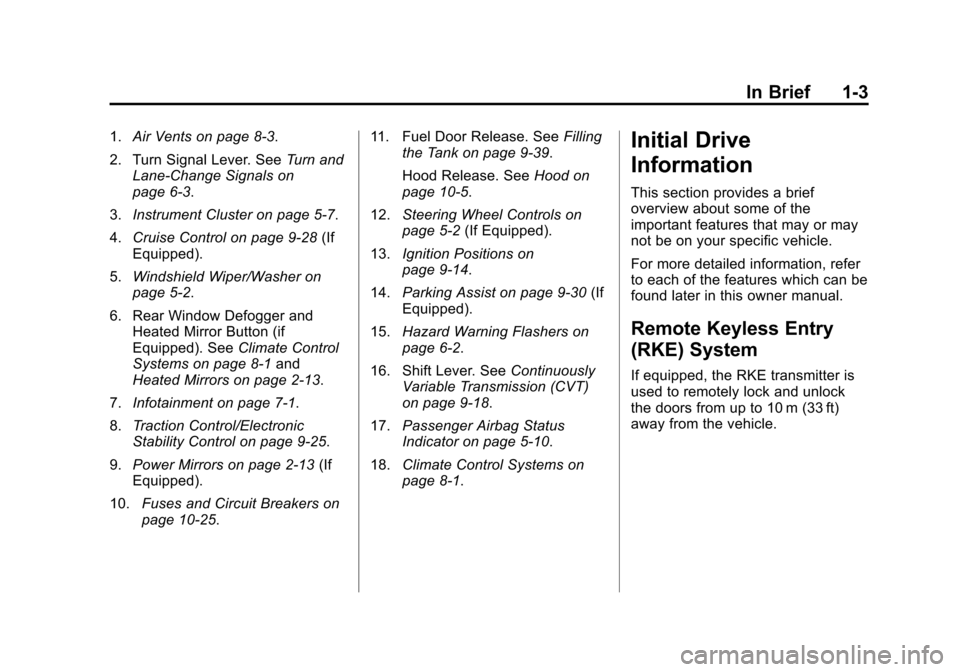
Black plate (3,1)Chevrolet City Express Owner Manual (GMNA-Localizing-U.S./Canada-
7707496) - 2015 - CRC - 11/26/14
In Brief 1-3
1.Air Vents on page 8-3.
2. Turn Signal Lever. See Turn and
Lane-Change Signals on
page 6-3.
3. Instrument Cluster on page 5-7.
4. Cruise Control on page 9-28 (If
Equipped).
5. Windshield Wiper/Washer on
page 5-2.
6. Rear Window Defogger and Heated Mirror Button (if
Equipped). See Climate Control
Systems on page 8-1 and
Heated Mirrors on page 2-13.
7. Infotainment on page 7-1.
8. Traction Control/Electronic
Stability Control on page 9-25.
9. Power Mirrors on page 2-13 (If
Equipped).
10. Fuses and Circuit Breakers on
page 10-25. 11. Fuel Door Release. See
Filling
the Tank on page 9-39.
Hood Release. See Hood on
page 10-5.
12. Steering Wheel Controls on
page 5-2 (If Equipped).
13. Ignition Positions on
page 9-14.
14. Parking Assist on page 9-30 (If
Equipped).
15. Hazard Warning Flashers on
page 6-2.
16. Shift Lever. See Continuously
Variable Transmission (CVT)
on page 9-18.
17. Passenger Airbag Status
Indicator on page 5-10.
18. Climate Control Systems on
page 8-1.Initial Drive
Information
This section provides a brief
overview about some of the
important features that may or may
not be on your specific vehicle.
For more detailed information, refer
to each of the features which can be
found later in this owner manual.
Remote Keyless Entry
(RKE) System
If equipped, the RKE transmitter is
used to remotely lock and unlock
the doors from up to 10 m (33 ft)
away from the vehicle.
Page 20 of 297
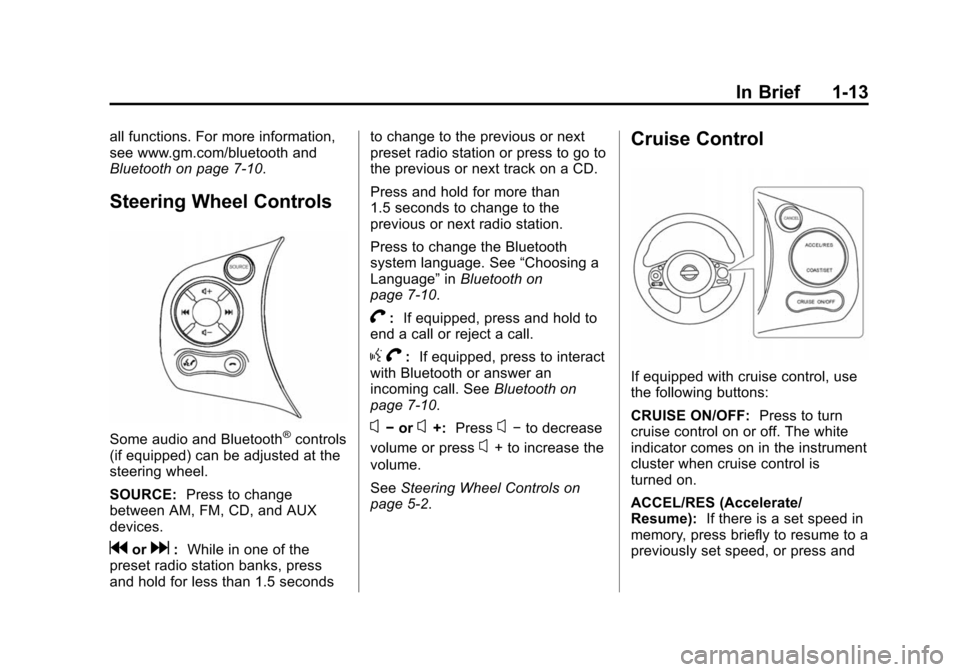
Black plate (13,1)Chevrolet City Express Owner Manual (GMNA-Localizing-U.S./Canada-
7707496) - 2015 - CRC - 11/26/14
In Brief 1-13
all functions. For more information,
see www.gm.com/bluetooth and
Bluetooth on page 7-10.
Steering Wheel Controls
Some audio and Bluetooth®controls
(if equipped) can be adjusted at the
steering wheel.
SOURCE: Press to change
between AM, FM, CD, and AUX
devices.
gord: While in one of the
preset radio station banks, press
and hold for less than 1.5 seconds to change to the previous or next
preset radio station or press to go to
the previous or next track on a CD.
Press and hold for more than
1.5 seconds to change to the
previous or next radio station.
Press to change the Bluetooth
system language. See
“Choosing a
Language” inBluetooth on
page 7-10.
V: If equipped, press and hold to
end a call or reject a call.
g V: If equipped, press to interact
with Bluetooth or answer an
incoming call. See Bluetooth on
page 7-10.
x− orx+: Pressx−to decrease
volume or press
x+ to increase the
volume.
See Steering Wheel Controls on
page 5-2.
Cruise Control
If equipped with cruise control, use
the following buttons:
CRUISE ON/OFF: Press to turn
cruise control on or off. The white
indicator comes on in the instrument
cluster when cruise control is
turned on.
ACCEL/RES (Accelerate/
Resume): If there is a set speed in
memory, press briefly to resume to a
previously set speed, or press and
Page 66 of 297
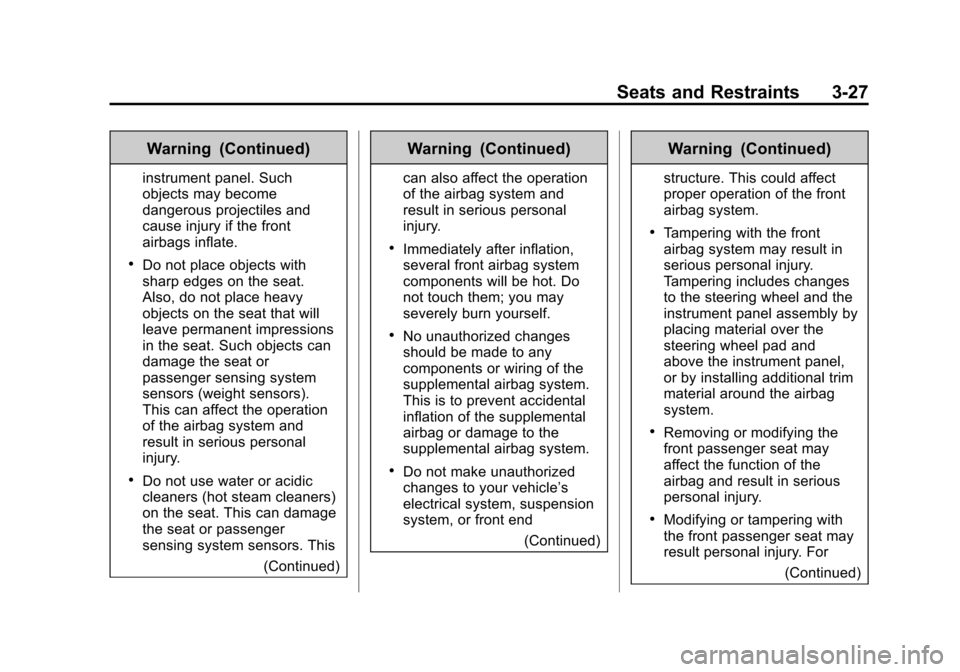
Black plate (27,1)Chevrolet City Express Owner Manual (GMNA-Localizing-U.S./Canada-
7707496) - 2015 - CRC - 11/26/14
Seats and Restraints 3-27
Warning (Continued)
instrument panel. Such
objects may become
dangerous projectiles and
cause injury if the front
airbags inflate.
.Do not place objects with
sharp edges on the seat.
Also, do not place heavy
objects on the seat that will
leave permanent impressions
in the seat. Such objects can
damage the seat or
passenger sensing system
sensors (weight sensors).
This can affect the operation
of the airbag system and
result in serious personal
injury.
.Do not use water or acidic
cleaners (hot steam cleaners)
on the seat. This can damage
the seat or passenger
sensing system sensors. This(Continued)
Warning (Continued)
can also affect the operation
of the airbag system and
result in serious personal
injury.
.Immediately after inflation,
several front airbag system
components will be hot. Do
not touch them; you may
severely burn yourself.
.No unauthorized changes
should be made to any
components or wiring of the
supplemental airbag system.
This is to prevent accidental
inflation of the supplemental
airbag or damage to the
supplemental airbag system.
.Do not make unauthorized
changes to your vehicle’s
electrical system, suspension
system, or front end
(Continued)
Warning (Continued)
structure. This could affect
proper operation of the front
airbag system.
.Tampering with the front
airbag system may result in
serious personal injury.
Tampering includes changes
to the steering wheel and the
instrument panel assembly by
placing material over the
steering wheel pad and
above the instrument panel,
or by installing additional trim
material around the airbag
system.
.Removing or modifying the
front passenger seat may
affect the function of the
airbag and result in serious
personal injury.
.Modifying or tampering with
the front passenger seat may
result personal injury. For(Continued)
Page 68 of 297
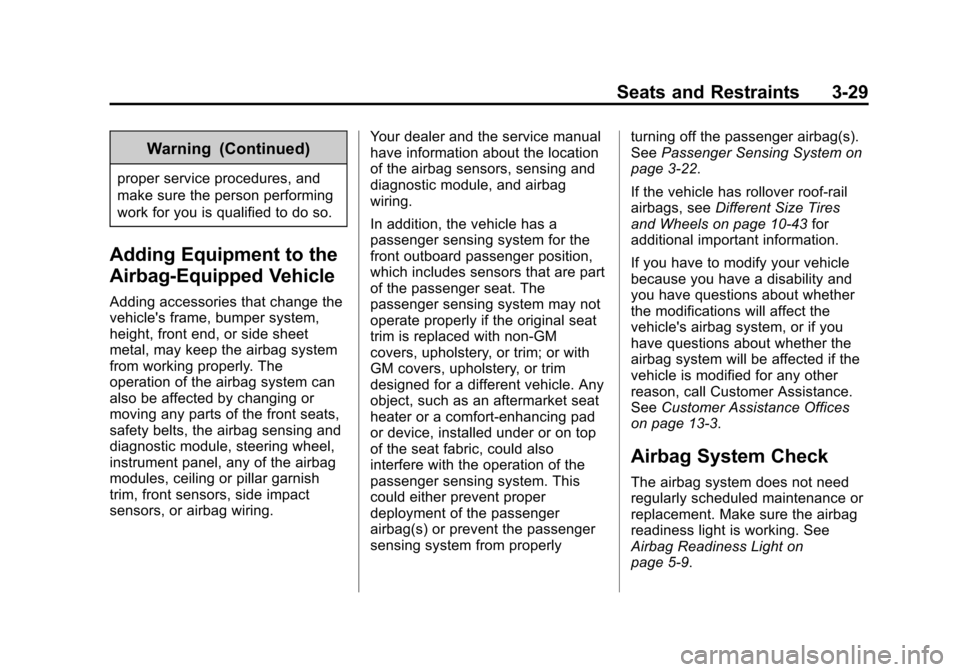
Black plate (29,1)Chevrolet City Express Owner Manual (GMNA-Localizing-U.S./Canada-
7707496) - 2015 - CRC - 11/26/14
Seats and Restraints 3-29
Warning (Continued)
proper service procedures, and
make sure the person performing
work for you is qualified to do so.
Adding Equipment to the
Airbag-Equipped Vehicle
Adding accessories that change the
vehicle's frame, bumper system,
height, front end, or side sheet
metal, may keep the airbag system
from working properly. The
operation of the airbag system can
also be affected by changing or
moving any parts of the front seats,
safety belts, the airbag sensing and
diagnostic module, steering wheel,
instrument panel, any of the airbag
modules, ceiling or pillar garnish
trim, front sensors, side impact
sensors, or airbag wiring.Your dealer and the service manual
have information about the location
of the airbag sensors, sensing and
diagnostic module, and airbag
wiring.
In addition, the vehicle has a
passenger sensing system for the
front outboard passenger position,
which includes sensors that are part
of the passenger seat. The
passenger sensing system may not
operate properly if the original seat
trim is replaced with non-GM
covers, upholstery, or trim; or with
GM covers, upholstery, or trim
designed for a different vehicle. Any
object, such as an aftermarket seat
heater or a comfort-enhancing pad
or device, installed under or on top
of the seat fabric, could also
interfere with the operation of the
passenger sensing system. This
could either prevent proper
deployment of the passenger
airbag(s) or prevent the passenger
sensing system from properlyturning off the passenger airbag(s).
See
Passenger Sensing System on
page 3-22.
If the vehicle has rollover roof-rail
airbags, see Different Size Tires
and Wheels on page 10-43 for
additional important information.
If you have to modify your vehicle
because you have a disability and
you have questions about whether
the modifications will affect the
vehicle's airbag system, or if you
have questions about whether the
airbag system will be affected if the
vehicle is modified for any other
reason, call Customer Assistance.
See Customer Assistance Offices
on page 13-3.
Airbag System Check
The airbag system does not need
regularly scheduled maintenance or
replacement. Make sure the airbag
readiness light is working. See
Airbag Readiness Light on
page 5-9.
Page 89 of 297
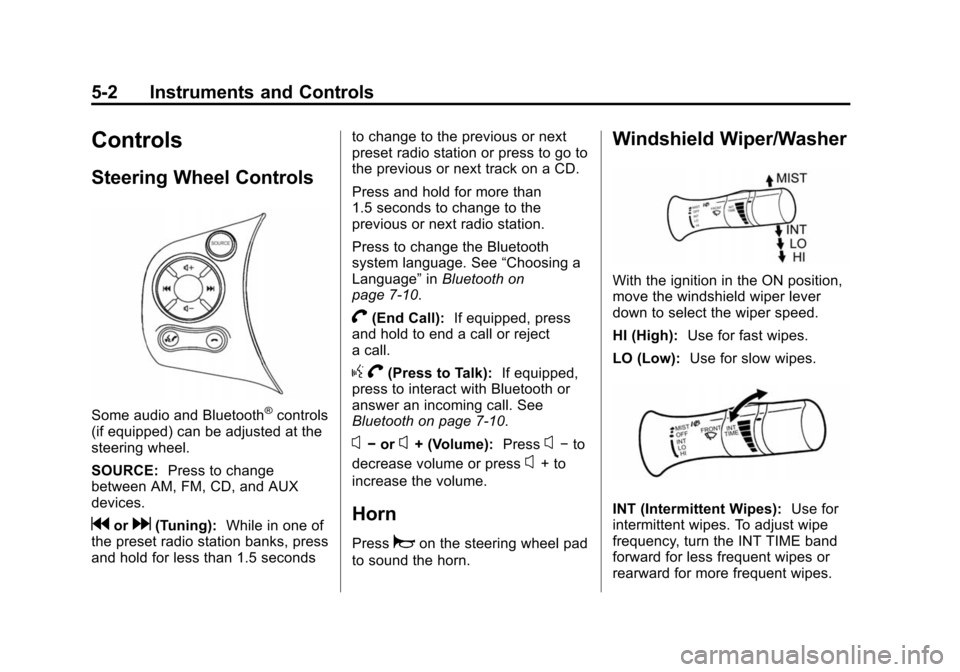
Black plate (2,1)Chevrolet City Express Owner Manual (GMNA-Localizing-U.S./Canada-
7707496) - 2015 - CRC - 11/26/14
5-2 Instruments and Controls
Controls
Steering Wheel Controls
Some audio and Bluetooth®controls
(if equipped) can be adjusted at the
steering wheel.
SOURCE: Press to change
between AM, FM, CD, and AUX
devices.
gord(Tuning): While in one of
the preset radio station banks, press
and hold for less than 1.5 seconds to change to the previous or next
preset radio station or press to go to
the previous or next track on a CD.
Press and hold for more than
1.5 seconds to change to the
previous or next radio station.
Press to change the Bluetooth
system language. See
“Choosing a
Language” inBluetooth on
page 7-10.
V(End Call): If equipped, press
and hold to end a call or reject
a call.
g V(Press to Talk): If equipped,
press to interact with Bluetooth or
answer an incoming call. See
Bluetooth on page 7-10.
x− orx+ (Volume): Pressx−to
decrease volume or press
x+ to
increase the volume.
Horn
Pressaon the steering wheel pad
to sound the horn.
Windshield Wiper/Washer
With the ignition in the ON position,
move the windshield wiper lever
down to select the wiper speed.
HI (High): Use for fast wipes.
LO (Low): Use for slow wipes.
INT (Intermittent Wipes): Use for
intermittent wipes. To adjust wipe
frequency, turn the INT TIME band
forward for less frequent wipes or
rearward for more frequent wipes.
Page 100 of 297
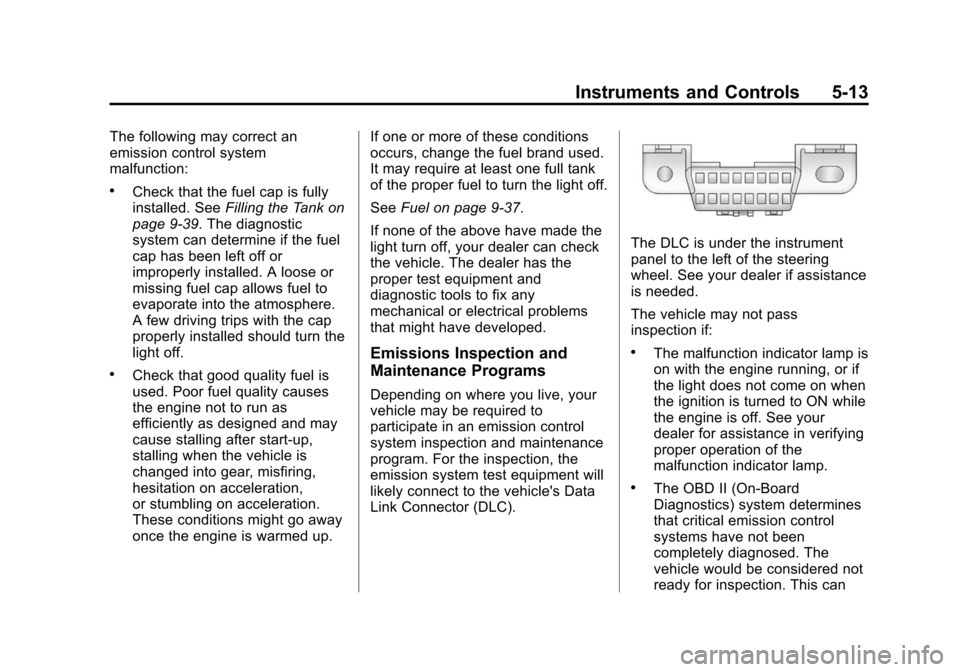
Black plate (13,1)Chevrolet City Express Owner Manual (GMNA-Localizing-U.S./Canada-
7707496) - 2015 - CRC - 11/26/14
Instruments and Controls 5-13
The following may correct an
emission control system
malfunction:
.Check that the fuel cap is fully
installed. SeeFilling the Tank on
page 9-39. The diagnostic
system can determine if the fuel
cap has been left off or
improperly installed. A loose or
missing fuel cap allows fuel to
evaporate into the atmosphere.
A few driving trips with the cap
properly installed should turn the
light off.
.Check that good quality fuel is
used. Poor fuel quality causes
the engine not to run as
efficiently as designed and may
cause stalling after start-up,
stalling when the vehicle is
changed into gear, misfiring,
hesitation on acceleration,
or stumbling on acceleration.
These conditions might go away
once the engine is warmed up. If one or more of these conditions
occurs, change the fuel brand used.
It may require at least one full tank
of the proper fuel to turn the light off.
See
Fuel on page 9-37.
If none of the above have made the
light turn off, your dealer can check
the vehicle. The dealer has the
proper test equipment and
diagnostic tools to fix any
mechanical or electrical problems
that might have developed.
Emissions Inspection and
Maintenance Programs
Depending on where you live, your
vehicle may be required to
participate in an emission control
system inspection and maintenance
program. For the inspection, the
emission system test equipment will
likely connect to the vehicle's Data
Link Connector (DLC).
The DLC is under the instrument
panel to the left of the steering
wheel. See your dealer if assistance
is needed.
The vehicle may not pass
inspection if:
.The malfunction indicator lamp is
on with the engine running, or if
the light does not come on when
the ignition is turned to ON while
the engine is off. See your
dealer for assistance in verifying
proper operation of the
malfunction indicator lamp.
.The OBD II (On-Board
Diagnostics) system determines
that critical emission control
systems have not been
completely diagnosed. The
vehicle would be considered not
ready for inspection. This can
Page 128 of 297
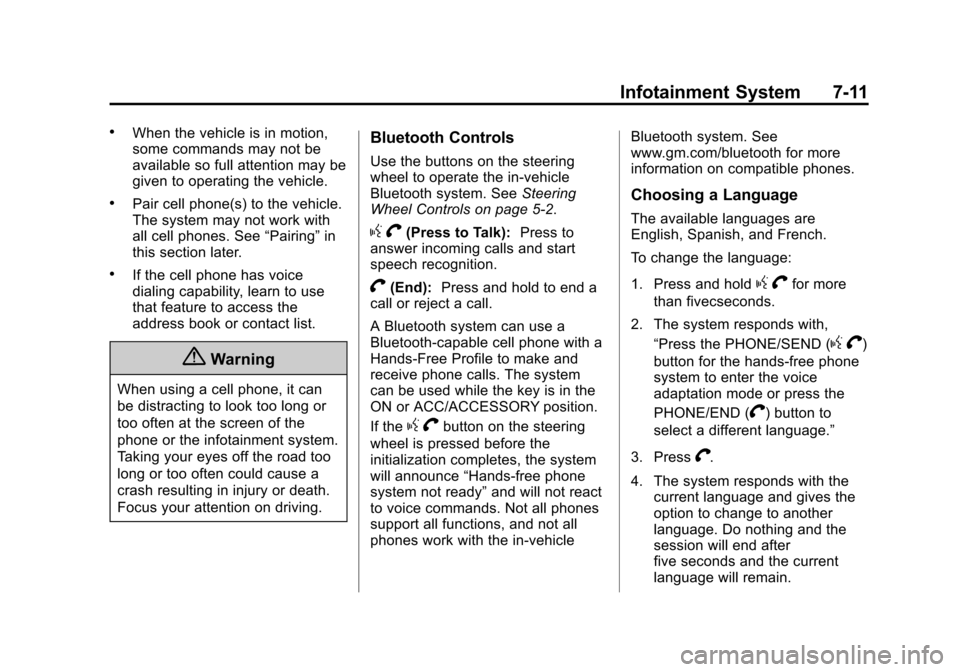
Black plate (11,1)Chevrolet City Express Owner Manual (GMNA-Localizing-U.S./Canada-
7707496) - 2015 - CRC - 11/26/14
Infotainment System 7-11
.When the vehicle is in motion,
some commands may not be
available so full attention may be
given to operating the vehicle.
.Pair cell phone(s) to the vehicle.
The system may not work with
all cell phones. See“Pairing”in
this section later.
.If the cell phone has voice
dialing capability, learn to use
that feature to access the
address book or contact list.
{Warning
When using a cell phone, it can
be distracting to look too long or
too often at the screen of the
phone or the infotainment system.
Taking your eyes off the road too
long or too often could cause a
crash resulting in injury or death.
Focus your attention on driving.
Bluetooth Controls
Use the buttons on the steering
wheel to operate the in-vehicle
Bluetooth system. See Steering
Wheel Controls on page 5-2.
g V(Press to Talk): Press to
answer incoming calls and start
speech recognition.
V(End): Press and hold to end a
call or reject a call.
A Bluetooth system can use a
Bluetooth-capable cell phone with a
Hands-Free Profile to make and
receive phone calls. The system
can be used while the key is in the
ON or ACC/ACCESSORY position.
If the
g Vbutton on the steering
wheel is pressed before the
initialization completes, the system
will announce “Hands-free phone
system not ready” and will not react
to voice commands. Not all phones
support all functions, and not all
phones work with the in-vehicle Bluetooth system. See
www.gm.com/bluetooth for more
information on compatible phones.
Choosing a Language
The available languages are
English, Spanish, and French.
To change the language:
1. Press and hold
g
Vfor more
than fivecseconds.
2. The system responds with, “Press the PHONE/SEND (
gV)
button for the hands-free phone
system to enter the voice
adaptation mode or press the
PHONE/END (
V) button to
select a different language.”
3. Press
V.
4. The system responds with the current language and gives the
option to change to another
language. Do nothing and the
session will end after
five seconds and the current
language will remain.
Page 129 of 297
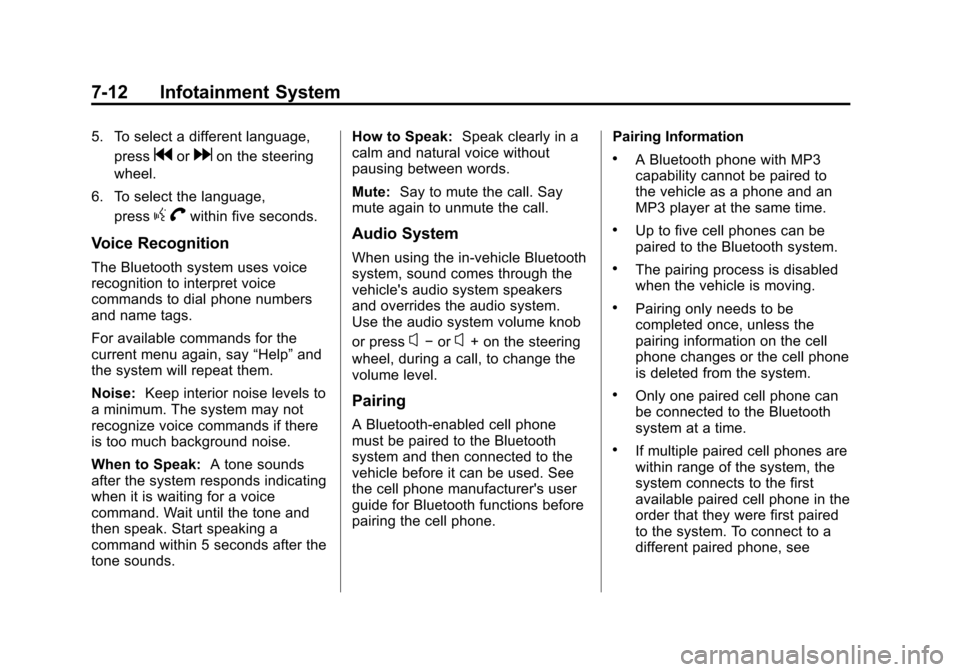
Black plate (12,1)Chevrolet City Express Owner Manual (GMNA-Localizing-U.S./Canada-
7707496) - 2015 - CRC - 11/26/14
7-12 Infotainment System
5. To select a different language,press
gordon the steering
wheel.
6. To select the language, press
gVwithin five seconds.
Voice Recognition
The Bluetooth system uses voice
recognition to interpret voice
commands to dial phone numbers
and name tags.
For available commands for the
current menu again, say “Help”and
the system will repeat them.
Noise: Keep interior noise levels to
a minimum. The system may not
recognize voice commands if there
is too much background noise.
When to Speak: A tone sounds
after the system responds indicating
when it is waiting for a voice
command. Wait until the tone and
then speak. Start speaking a
command within 5 seconds after the
tone sounds. How to Speak:
Speak clearly in a
calm and natural voice without
pausing between words.
Mute: Say to mute the call. Say
mute again to unmute the call.
Audio System
When using the in-vehicle Bluetooth
system, sound comes through the
vehicle's audio system speakers
and overrides the audio system.
Use the audio system volume knob
or press
x− orx+ on the steering
wheel, during a call, to change the
volume level.
Pairing
A Bluetooth-enabled cell phone
must be paired to the Bluetooth
system and then connected to the
vehicle before it can be used. See
the cell phone manufacturer's user
guide for Bluetooth functions before
pairing the cell phone. Pairing Information
.A Bluetooth phone with MP3
capability cannot be paired to
the vehicle as a phone and an
MP3 player at the same time.
.Up to five cell phones can be
paired to the Bluetooth system.
.The pairing process is disabled
when the vehicle is moving.
.Pairing only needs to be
completed once, unless the
pairing information on the cell
phone changes or the cell phone
is deleted from the system.
.Only one paired cell phone can
be connected to the Bluetooth
system at a time.
.If multiple paired cell phones are
within range of the system, the
system connects to the first
available paired cell phone in the
order that they were first paired
to the system. To connect to a
different paired phone, see
Page 146 of 297
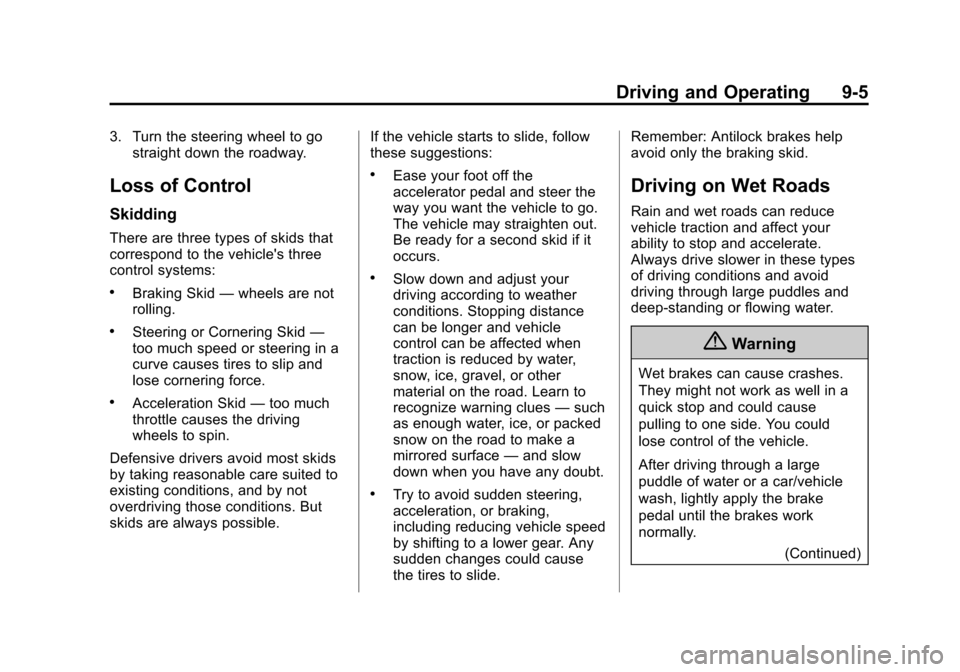
Black plate (5,1)Chevrolet City Express Owner Manual (GMNA-Localizing-U.S./Canada-
7707496) - 2015 - CRC - 11/26/14
Driving and Operating 9-5
3. Turn the steering wheel to gostraight down the roadway.
Loss of Control
Skidding
There are three types of skids that
correspond to the vehicle's three
control systems:
.Braking Skid —wheels are not
rolling.
.Steering or Cornering Skid —
too much speed or steering in a
curve causes tires to slip and
lose cornering force.
.Acceleration Skid —too much
throttle causes the driving
wheels to spin.
Defensive drivers avoid most skids
by taking reasonable care suited to
existing conditions, and by not
overdriving those conditions. But
skids are always possible. If the vehicle starts to slide, follow
these suggestions:
.Ease your foot off the
accelerator pedal and steer the
way you want the vehicle to go.
The vehicle may straighten out.
Be ready for a second skid if it
occurs.
.Slow down and adjust your
driving according to weather
conditions. Stopping distance
can be longer and vehicle
control can be affected when
traction is reduced by water,
snow, ice, gravel, or other
material on the road. Learn to
recognize warning clues
—such
as enough water, ice, or packed
snow on the road to make a
mirrored surface —and slow
down when you have any doubt.
.Try to avoid sudden steering,
acceleration, or braking,
including reducing vehicle speed
by shifting to a lower gear. Any
sudden changes could cause
the tires to slide. Remember: Antilock brakes help
avoid only the braking skid.
Driving on Wet Roads
Rain and wet roads can reduce
vehicle traction and affect your
ability to stop and accelerate.
Always drive slower in these types
of driving conditions and avoid
driving through large puddles and
deep‐standing or flowing water.
{Warning
Wet brakes can cause crashes.
They might not work as well in a
quick stop and could cause
pulling to one side. You could
lose control of the vehicle.
After driving through a large
puddle of water or a car/vehicle
wash, lightly apply the brake
pedal until the brakes work
normally.
(Continued)
Page 150 of 297
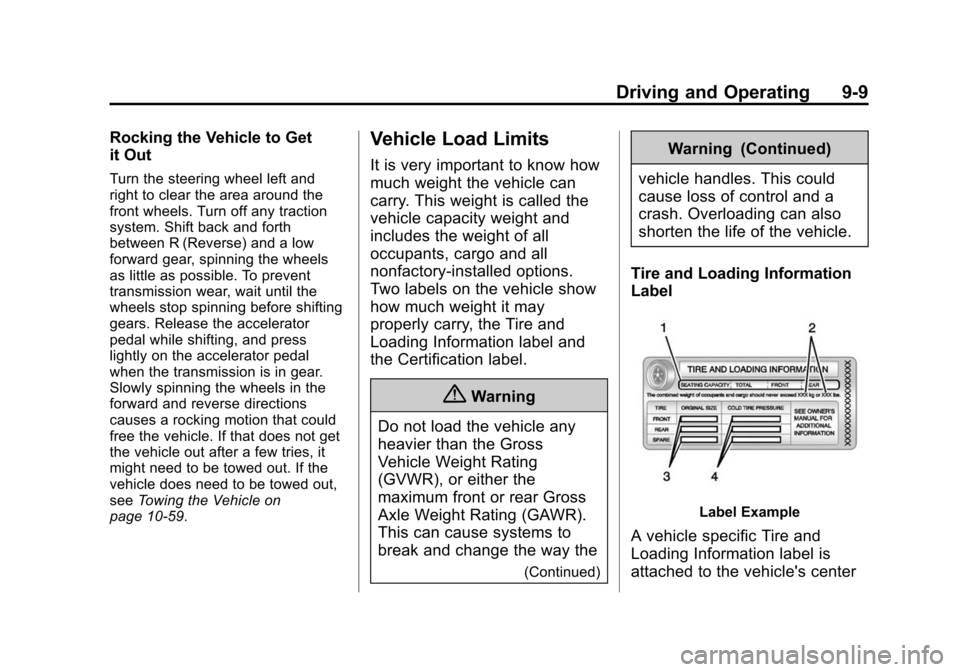
Black plate (9,1)Chevrolet City Express Owner Manual (GMNA-Localizing-U.S./Canada-
7707496) - 2015 - CRC - 11/26/14
Driving and Operating 9-9
Rocking the Vehicle to Get
it Out
Turn the steering wheel left and
right to clear the area around the
front wheels. Turn off any traction
system. Shift back and forth
between R (Reverse) and a low
forward gear, spinning the wheels
as little as possible. To prevent
transmission wear, wait until the
wheels stop spinning before shifting
gears. Release the accelerator
pedal while shifting, and press
lightly on the accelerator pedal
when the transmission is in gear.
Slowly spinning the wheels in the
forward and reverse directions
causes a rocking motion that could
free the vehicle. If that does not get
the vehicle out after a few tries, it
might need to be towed out. If the
vehicle does need to be towed out,
seeTowing the Vehicle on
page 10-59.
Vehicle Load Limits
It is very important to know how
much weight the vehicle can
carry. This weight is called the
vehicle capacity weight and
includes the weight of all
occupants, cargo and all
nonfactory-installed options.
Two labels on the vehicle show
how much weight it may
properly carry, the Tire and
Loading Information label and
the Certification label.
{Warning
Do not load the vehicle any
heavier than the Gross
Vehicle Weight Rating
(GVWR), or either the
maximum front or rear Gross
Axle Weight Rating (GAWR).
This can cause systems to
break and change the way the
(Continued)
Warning (Continued)
vehicle handles. This could
cause loss of control and a
crash. Overloading can also
shorten the life of the vehicle.
Tire and Loading Information
Label
Label Example
A vehicle specific Tire and
Loading Information label is
attached to the vehicle's center